- When: Saturday 8th December, 6.30 pm
- Where: Community Hall
- BYO meat, sausages or whatever you want on the BBQ
- Please bring a salad or sweet to share
- The Bar will be OPEN with the usual low priced drinks
- Come and join us for the last Social of 2018









In a previous post (5 November 2018) I reported on the frenetic courtship activity of the Victoria’s Riflebird at Paluma during the height of the breeding season for these birds. I noted that many of the juvenile male birds were practising their skills at displaying for females.
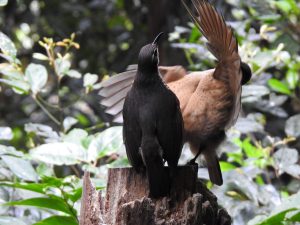
While the young males continue to compete for the attention of females, the adult male birds are also displaying with all the finesse that maturity brings. I captured the elaborate courtship display of one adult male bird who managed to win over his female companion. The courtship ritual and display lasted for almost 10 minutes and was a sight to behold.
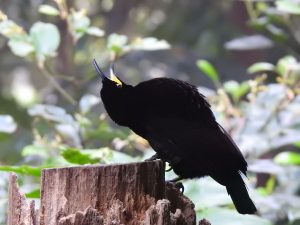
2. A female bird arrives and sits in a nearby tree. He is instantly alert and almost appears to take a bow in her direction.

3. He leaves his perch and flies into the nearby canopy to join her, sitting next to her on a branch. He puffs-up his whole body, raises his wings and the performance begins.
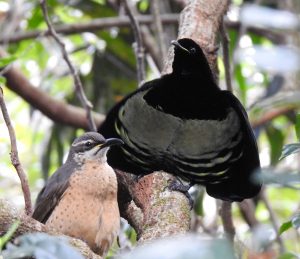
4. He displays frantically over and over with raised flapping wings until he has her full attention. She was looking quite disinterested for a time as the photographs show!.
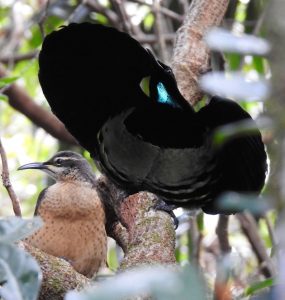
5. Finally he has her full attention and they copulate. No photographs included here, privacy please!
6. He then flies back to his original perch and turns to display again, raising his wings in the direction of the female who is still sitting in the canopy.
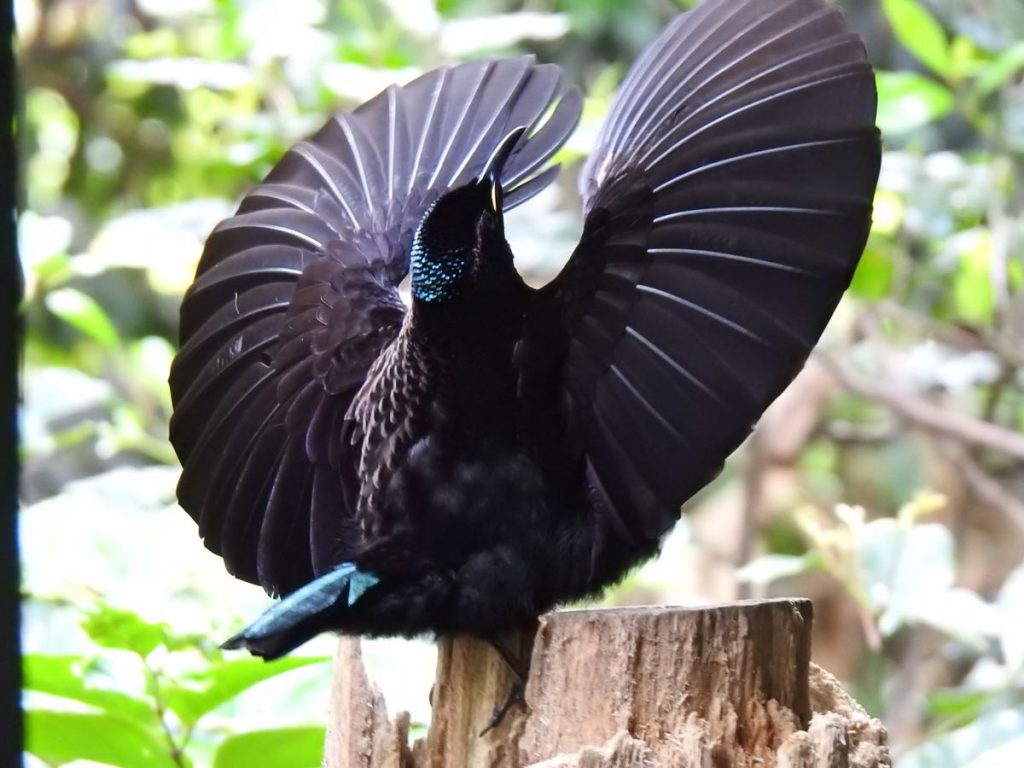
What an amazing and remarkable bird and a truly memorable 10 minutes of my life! Right place at the right time. Or, just another day in the paradise called Paluma.
Article & Photographs by Michele Bird (no pun intended).
On a sunny Friday 19th October, the judging of the 2018 Bunnings Paluma Garden Competition took place. Lynn Hyland accompanied the judges around the acreage blocks, whilst Jamie Oliver escorted the judges around the village gardens. Natalie Pace and her mother Denise, both past judges for the Townsville Garden Competition were our 2018 judges. Natalie held an Open Garden in September at her Rollingstone property and attracted 350 visitors. There really are many keen gardeners in Townsville. She is encouraging us to consider having an Open Garden event in Paluma next year. Well Paluma gardeners what do you think about this?
The Garden Competition winners were announced at our PDCA Social on Saturday 3rd November. They are:-
1. Best Business Garden Winner is Gumburu
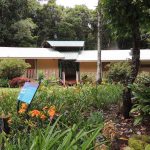
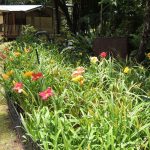
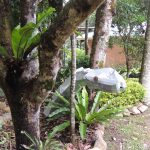
2. Best Acreage Garden Winner is Don Battersby


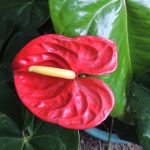
3. Best Residential Village Garden Winner is Nick and Glenda Van Rynswoud. The Alison Evans Memorial Trophy was also awarded to Nick and Glenda Van Rynswoud.
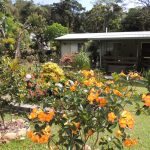
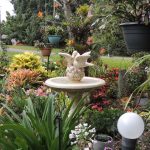
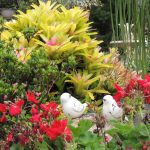
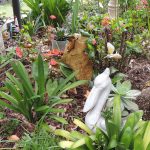


4. Highly Commended Residential Village Garden Winner is Peter and Dorothy Klump

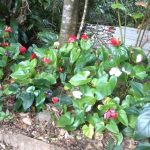
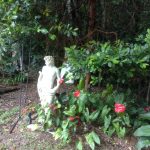
5. An Individual Plant, Garden Bed, Herb Garden or Vegetable Patch, Outdoor Space, etc Winner is Michele Bird
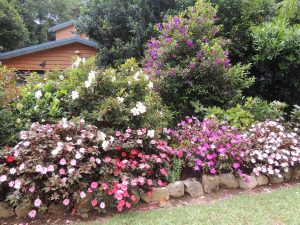
Paluma is blessed with a cooler climate than the coast and hence we are able to successfully grow many plants that aren’t seen in Townsville gardens. During the judging, some of the plants that were in full bloom were the spirea, hippeastrums, New Guinea impatiens, daylilies and orchids to name just a few. Do check out ‘What’s Flowering In Paluma’ on the website to keep abreast of the latest showpieces in Paluma gardens.
Article by Lynn Hyland with Photos by Michele Bird & Colwyn Campbell
 Paluma’s ‘Purple Haze’ – Tibouchina ‘Chameleon’
Paluma’s ‘Purple Haze’ – Tibouchina ‘Chameleon’This website features numerous photographs of the many varieties of flowering Tibouchina’s which thrive in the cool mountain climate at Paluma. Most gardens have at least one of these beautiful plants which burst into bloom a couple of times a year, usually in the warmer months.
The ‘Chameleon’ variety is at its flowering best at present and there is a spectacular specimen catching everyone’s eye at No. 16 Mount Spec Road. The large shrub is a blaze of colour with hundreds of flowers and many buds still to open, ensuring a long flowering period of two weeks or more. Many locals and visitors have stopped to admire and photograph this flowering gem over the past week. You just can’t miss it, as it can be seen from a considerable distance along Mount Spec Road.
Tibouchina ‘Chameleon’ is so-named because the flowers change colour as they mature. The flowers open as pure white and then ‘ripen’ to varying shades of purple, mauve and pink. The effect is that the plant will have a mix of flower shades at the one time- an amazing ‘Purple Haze’.
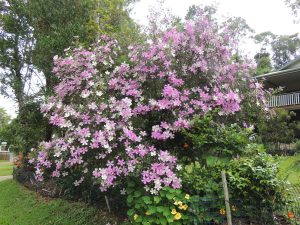
Other flowering Tibouchina’s are located at No. 40 and No. 52 Mount Spec Road. Take a walk through the misty village of Paluma and check out the ‘Purple Haze’. When Jimi Hendrix penned his famous song, he was surely inspired by a Tibouchina Chameleon!
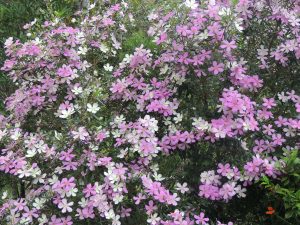
Text & Photos by Michele Bird
On Sunday 11 November at 11 am a small group of Paluma residents and visitors congregated at the Community Hall to acknowledge Armistice Day and the 100 year anniversary of the end of World War 1.
The commemoration included an audio rendition of The Last Post and a minute of silence, followed by a short anecdote from Les Hyland.
Many thanks to Len Cook for raising the flag on the day and to Lynda Radbone for her technical assistance. Len also provided the morning tea!

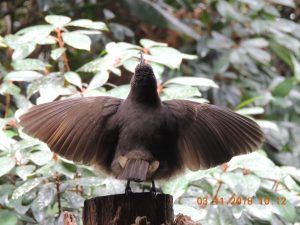
The breeding season for the Victoria’s Rifle Bird is between September and January. Courtship behaviour and displaying by juvenile male birds is in full swing at Paluma during the peak of the breeding season in early November. The elaborate courtship rituals are something to see!
Over several days, numerous young male birds have been sighted on ‘perches’ high in the rainforest canopy, carrying out their elaborate dance displays to attract the females. At one location on a suitable tree stump I observed three birds displaying in quick succession, one after the other on the same perch. The displays were accompanied by the distinctive raucous, raspy calls which were quickly answered by other birds throughout the nearby forest. The distinctive clapping sound made by the male birds rapidly alternating their wings during displaying was also heard from the surrounding rainforest.
Cliff and Dawn Frith have spent many years studying the courtship display and mating habits of rifle birds. Much of their research was based at Paluma. They describe the courtship display as typically having three discrete components:
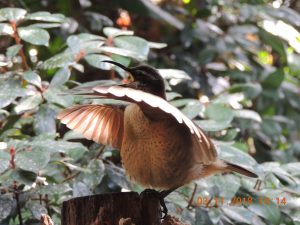
2. Circular wings and gape display
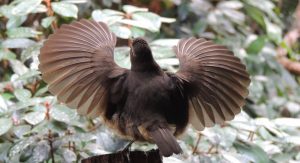
3. Alternate wing clap – this involves the rapid, alternating ‘clapping’ of the wings whereby the female is ’embraced’ within the male birds wings. The tempo of the wing clapping increases until copulation.
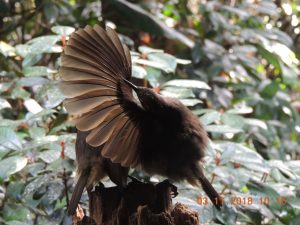
Just describing the remarkable courtship behaviour of the male rifle bird does not do it justice. The video below captures a short sequence of the typical display.
Text & Photos by Michele Bird. Video by Michele Bird & Jamie Oliver.
For some months now we have had a Pale Yellow Robin resident close to our house on the five acre blocks. He [or very possibly, she] perches in the Murraya tree close to our kitchen window and mounts an attack on the window pane on the left hand side from our perspective looking out. His claws land on the glass and he drops down onto the lintel at the base of the window. He usually pauses for a few seconds before repeating the attack two panes to the right and again usually pauses looking quizzically at you if you happen to be at the sink, totally unfazed by the sight of humans. He then proceeds to circle the house, usually anti-clockwise but not invariably so, attacking windows randomly before returning to the tree and repeating the antics over and over for maybe an hour or more before going off duty for a period. We think he must be eating during this gap as he has an annoying habit of leaving a calling card on or below the windows in the kitchen.
More recently he has discovered that the car has mirrors and he is fascinated by the second bird and spits at the reflection in the mirror and leaves copious deposits on the curve above the door handle which have to be washed off frequently to avoid damage to the paintwork. You may deduce that we are a bit cheesed off with this behaviour and have taken to thwarting the car attacks with our car cover which is pretty successful as he can’t even get at the windows. He still looks for the now covered car windows but has more or less given them up as a lost cause.
But he still does the house daily – we don’t know if our presence engenders his behaviour as we can’t see what happens when we are not there ! He is extremely hard to photograph but the photograph below is at the kitchen window by the sink.
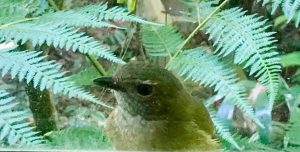
Text & Photo by Les Hyland
LEST WE FORGET
REMEMBRANCE DAY SUNDAY 11 NOVEMBER
Remembrance Day Gathering, 11 AM on Sunday 11 November 2018 at the Paluma Community Hall.
Please meet at the Community Hall at approximately 10.45 AM in preparation for the raising of the flag and a minute of silence at 11 AM to commemorate Remembrance Day.
ALL PALUMA RESIDENTS AND VISITORS WELCOME
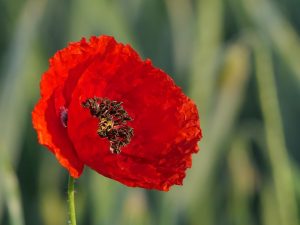
Paluma gardens never cease to surprise and delight with the variety of spectacular blooms to be found here. In the garden of No. 15 Mount Spec Road, the brilliant red flowers of a Tree Waratah flame in the crown of this tall, slender tree. Higher than the house roof, the flowers can be easily missed unless you are scanning the tree-tops for birds.
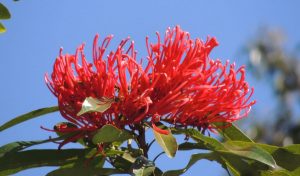
Native to the North Queensland rainforest, the Tree Waratah and its natural habitat on the Atherton Tableland, have largely disappeared there due to clearing for grazing and agriculture. The tree is known for its beautiful pink timber.
Formerly known as Oreocallis wickhamii, it has undergone a name change and is now classified as genus Alloxylon in reference to its unique timber. There are two species within the Queensland tropical rainforest – Alloxylon flamelleum, (which I suspect is the species flowering in the Paluma garden), and Alloxylon wickhamii. The common names for these trees are Queensland Waratah, Pink Silky Oak and Red Silky Oak for A. flamelleum and Tree Waratah, Satin Silky Oak and Pink Silky Oak for A. wickhamii. All very confusing to a non-botanist: so much easier to identify it as ‘Tree Waratah’.
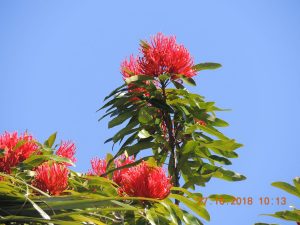
Take a short walk from Mount Spec Road along Lennox Crescent to the Townsville City Council Water Depot. Look up the driveway to see, rising behind the buildings and tower, a magnificent Melaleuca tree, its crown completely covered in dense white bloom. It gives the impression of being heavily snow-laden. This tree is Melaleuca linariifolia and not surprisingly, one of its common names is ‘Snow in Summer’.
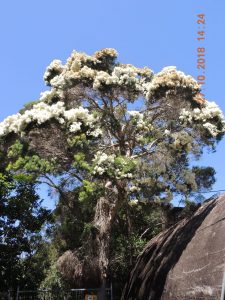 This small evergreen tree grows to a height of 6m to 10m. It is from the myrtle family and is endemic to New South Wales and Queensland. This particular specimen was planted in the early 1990’s (in 1993 or 1994) by long-time Paluma resident Kelly Davis. The trunk of this tree has thick sheets of papery bark. The flowers are a major attractant for bees, butterflies and birds.Unfortunately, the spectacular display of the ‘Snow in Summer’ will not last long; already some of the blooms are browning in the tropical heat.
This small evergreen tree grows to a height of 6m to 10m. It is from the myrtle family and is endemic to New South Wales and Queensland. This particular specimen was planted in the early 1990’s (in 1993 or 1994) by long-time Paluma resident Kelly Davis. The trunk of this tree has thick sheets of papery bark. The flowers are a major attractant for bees, butterflies and birds.Unfortunately, the spectacular display of the ‘Snow in Summer’ will not last long; already some of the blooms are browning in the tropical heat.

Text by Colwyn Campbell & Photos by Michele Bird
One of the many benefits of residing in the village of Paluma is that we are living close to nature. Encounters with the local wildlife are common for those of us living with the rainforest and the Wet Tropics World Heritage Area literally at our back door. On my house verandah there are numerous spiders, of varying sizes and species, happy to cohabit with me. My favourite spider is a rather large, hairy-legged huntsman that I call ‘Harry’.
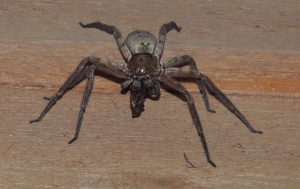
‘Harry the Huntsman’ lives in the kindling box by the back door. He takes refuge in the kindling box by day, but by night he stalks the verandah and house walls looking for prey. His favourite past time is to sit by the back door at night and jump towards me when I least expect it.
‘Harry’ is a Jungle Huntsman which are fast moving rainforest spiders (don’t I know it!). They are long-legged and mostly grey to brown in colour. They can grow to a body length of 30mm (Harry is approaching this size). Jungle Huntsman feed on a range of invertebrates including moths, crickets, cockroaches, flies and other spiders. Jungle Huntsman are covered in fine sensory hairs which are very sensitive to air movement. This helps them to detect the movement of prey and also the approach of predators.
These spiders lay eggs which are encased in a flat white silk egg sac. The female spider stays with the egg sac until the spiderlings hatch. The eggs hatch in 30 to 60 days (depending on the temperature) and several hundred spiderlings can emerge from one egg sac. (If ‘Harry’ is actually a ‘Harriet’ then I may have many more Jungle Huntsman on the verandah in the future).
Jungle Huntsman grow by shedding their exoskeleton, or moulting. The life span of most Huntsman species is 2 to 3 years. These spiders are non-venomous. Their predators include birds, geckoes and large wasps.
Text & Photo by Michele Bird